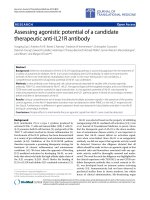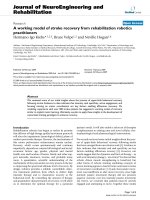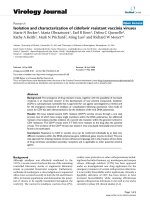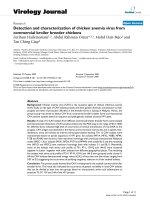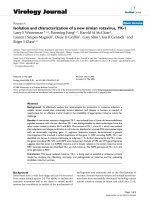báo cáo hóa học:" Fabrication and characterization of well-aligned and ultra-sharp silicon nanotip array" ppt
Bạn đang xem bản rút gọn của tài liệu. Xem và tải ngay bản đầy đủ của tài liệu tại đây (3.86 MB, 15 trang )
This Provisional PDF corresponds to the article as it appeared upon acceptance. Fully formatted
PDF and full text (HTML) versions will be made available soon.
Fabrication and characterization of well-aligned and ultra-sharp silicon nanotip
array
Nanoscale Research Letters 2012, 7:120 doi:10.1186/1556-276X-7-120
Chi-Chang Wu ()
Keng-Liang Ou ()
Ching-Li Tseng ()
ISSN 1556-276X
Article type Nano Express
Submission date 18 November 2011
Acceptance date 13 February 2012
Publication date 13 February 2012
Article URL />This peer-reviewed article was published immediately upon acceptance. It can be downloaded,
printed and distributed freely for any purposes (see copyright notice below).
Articles in Nanoscale Research Letters are listed in PubMed and archived at PubMed Central.
For information about publishing your research in Nanoscale Research Letters go to
/>For information about other SpringerOpen publications go to
Nanoscale Research Letters
© 2012 Wu et al. ; licensee Springer.
This is an open access article distributed under the terms of the Creative Commons Attribution License ( />which permits unrestricted use, distribution, and reproduction in any medium, provided the original work is properly cited.
- 1 -
Fabrication and characterization of well-aligned and ultra-sharp
silicon nanotip array
Chi-Chang Wu*
1,2
, Keng-Liang Ou
1,2
, and Ching-Li Tseng
1
1
Graduate Institute of Biomedical Materials and Tissue Engineering, Taipei Medical
University, Taipei, 11031, Taiwan
2
Research Center for Biomedical Devices, Taipei Medical University, Taipei, 11031,
Taiwan
*Corresponding author:
Email addresses:
CCW:
KLO:
CLT:
- 2 -
Abstract
Well-defined, uniform, and large-area nanoscaled tips are of great interest for
scanning probe microscopy and high-efficiency field emission. An ultra-sharp nanotip
causes higher electrical field and, hence, improves the emission current. In this paper,
a large-area and well-aligned ultra-sharp nanotip arrays by reactive ion etching and
oxidation techniques are fabricated. The apex of nanotips can be further sharpened to
reach 3-nm radius by subsequent oxidation and etching process. A schematic model to
explain the formation of nanotip array is proposed. When increasing the etching time,
the photoresist on top of the nanotip is also consumed, and the exposed silicon
substrate is etched away to form the nanotip. At the end, the photoresist is consumed
completely and a nanotip with pyramid-like shape is developed. The field emission
property was measured, and the turn-on field and work function of the ultra-sharp
nanotip was about 5.37 V/µm and 4.59 eV, respectively. A nanotip with an oxide
layer capped on the sidewall is also fabricated in this paper. Comparing to the
uncapped nanotip, the oxide-capped sample exhibits stable and excellent field
emission property against environmental disturbance.
Keywords: silicon nanotip; well-aligned; field emission; Fowler-Nordheim; oxide-
capped.
Background
Ultra-sharp nanotips are drawn a lot of attention because of their promising
applications in many fields such as electronics, microscopy, nanolithography, and
biology [1-3]. More recently, application of nanotip in high-efficiency field emission
[FE], flat panel displays, scanning probe microscopy, and scanning tunneling
microscopy are intensively investigated [4]. The efficiency of these techniques
strongly depends on the characterization of the tip. For instance, a high-brightness and
quick-response FE display can be obtained by a well-aligned nanotip array. FE is a
quantum phenomenon that electrons are emitted from the cathode by a large electric
field and tunneled through the surface of the tip array. This technique is a potential
method for the manufacture of high-quality display with features of thin panel
thickness, wide view angle, low power consumption, and high tolerance. Generally,
the tip-end size, as well as the arrangement of the nanotip array, plays an important
role in performing an effective FE [5]. A tip with smaller apex can induce higher
electrical field and, hence, significantly enhances the emission current [6-7].
Various materials are employed to form the nanotips [8-10]. Among them, silicon
is one of the most promising candidates to fabricate nanotips because it is the most
used materials and ease of fabrication in the micro-electronic field [11-13]. Numerous
technologies have been developed recently for the preparation of silicon nanotips,
including evaporation deposition, electroplating, anisotropic wet etching method, and
dry etching method [14-18]. Huang et al. used porous anodic alumina membrane as
the mask and obtained a Si nanotip array by removing the silicon oxide [SiO
2
] islands
which were formed during anodization of the Al/Si interface [14]; Cheng et al.
fabricated silicon nanotips through high-density hydrogen plasma etching [15]; Hsu et
al. proposed a one-step and self-masked dry etching technique for fabricating uniform
and high-single-crystal silicon nanotips [16]. These methods demonstrate simple
processes to fabricate ultra-sharp nanotips. The alignment of nanotip array is,
however, unsolvable issue because the nanotips are formed randomly by these
methods. Linn et al. developed a microfabrication-compatible technology using
- 3 -
inverted silicon pyramidal pits to fabricate the periodic gold nanopyramids with
nanoscale sharp tips [18]. Using this method, aligned silicon tip is obtained, but it is
difficult to fabricate nanotips with high aspect ratio and sharp end since only
pyramidal shape structures are provided.
In this work, Si nanotip arrays by combining the photolithography and reactive ion
etching technology are fabricated. The apex of the nanotip can reach down to 3 nm in
radius. By using this method, a large-area, well-aligned, and patternable nanotip array
with high aspect ratio, ultra-sharp tip end can be achieved. In addition, we propose a
formation scenario and model to explain the experiment results. The FE properties of
Si nanotip arrays are investigated. The results indicate that the FE properties of
nanotip arrays are improved when sharpening the tip end by oxidation process. We
also demonstrate an oxide-capped nanotip which is only tip-end exposed. The oxide-
capped sample exhibits stable and excellent field emission property against
environmental disturbance.
Methods
Fabrication of the nanotip
The ultra-sharp nanotip array was fabricated using a commercially available 6-in.,
(100)-oriented, p-type silicon wafers. After standard (NH
4
OH/H
2
O
2
= 3:1, then
HCl/H
2
O
2
= 3:1) and hydrofluoric acid [HF] cleaning, a 700-nm-thick photoresist [PR]
was coated using TEL Clean Track Model-MK8 system (Tokyo Electron Limited,
Tokyo, Japan), followed by 300 × 300 nm
2
square array was defined using the optical
exposure (Canon FPA-3000i5 stepper, Canon, Tokyo, Japan) systems. The plasma
etching system (Lam Research TCP9400SE, Lam Research Corporation, Fremont,
CA, USA) was then employed to form the pyramid-like tips. The etching power and
pressure were 300 W and 12 mTorr, respectively. The gas flow was Cl
2
/HBr = 35:125
sccm.
To further sharpen the tip, a SiO
2
was thermally grown to oxidize the sidewall of
the tips, and then, samples were immersed into a buffer oxide etch [BOE] (NH
4
F/HF
= 6:1) solution to fully remove the silicon oxide.
Fabrication of oxide-capped nanotip
The schematic representation of fabrication steps of the oxide-capped nanotip is
provided in Figure 1. Firstly, a 50-nm-thick SiO
2
film was thermally grown using a
furnace system (Figure 1b), and a PR was then spin-coated onto the surface. To match
the height of the nanotip, we tuned the rotation rate of the spin coating to decrease the
PR thickness. After PR coating, the samples were immersed into the PR stripper for 3
sec, and hence, the pinpoint of nanotip was exposed, as shown in Figure 1c. Then,
samples were immersed into the BOE solution to remove SiO
2
on the pinpoint surface.
Finally, the PR was then removed by H
2
SO
4
and H
2
O
2
mixture, and the nanotips with
an oxide capping layer on the sidewall was completed (Figure 1d).
Property analysis of the nanotip
Microstructure of the nanotip array was examined using SEM. The field emission
characteristics were measured at 1E-6 Torr using a Keithley 237 high-voltage
semiconductor parameter analyzer (Keithley Instruments, Inc., Cleveland, OH, USA).
The silicon nanotips served as the lower electrode, and the tungsten probe approached
- 4 -
the nanotips gradually to 100 nm. The tungsten probe was then applied a positive
voltage ranging from 0 to 1,000 V and measured the emission current.
Results and discussion
The progress of transformation of the tips and photoresist at different etching time is
displayed in Table 1. From the eagle-view and top-view scanning electron microscope
[SEM] images, it can be clearly seen that the size of PR is reducing upon the etching
time. Silicon beneath the PR is then exposed and etched away. Therefore, the shape of
the silicon underneath is gradually transformed from pillar to tip since the sidewall of
the silicon pillar is pared by etchant. Finally, the PR is consumed completely after 10-
min etching time, and a pyramid-like tip is then formed. The appearance of the
pyramid-like tip shows sharp apexes with 12 nm in radius and 500 nm in height. To
further sharpen the tip-end radius, the pyramid-like tip was treated to a thermal
oxidization process. After the sharpening process, the apex of nanotip can be reached
down to 3 nm in radius while retaining almost the same height.
Shape conversion of the tip at various etching times can be observed by top-view
images. The shape of the nanotip significantly influences the field emission property.
Interestingly, the exterior appearance of the tip is transforming with etching time. As
seen in Table 1, the top-view appearance of the initial PR is rectangular, while after 4-
min etching time, the tip is turning into round-corner pyramid shape; at 6-min etching
time, the corner of the pyramid shape becomes acute; after 10-min etching time, the
tip transforms to recessed pyramid shape. Although the mechanism needs to be
further studied, this phenomenon is imaginable from the point of view of etch
probability.
Based on the observation results in Table 1, we propose a formation model of the
ultra-sharp nanotip array. Figure 2 shows the schematic representation of nanotip
formation at different etching times. The coated PR on top of the tips serves as the
shielding mask to protect the underlying silicon (Figure 2a). The etching depth of
silicon is increased upon etching time, while the PR is also gradually etched away; the
exposed silicon is then increased and etched away. Therefore, the sidewall of the
silicon pillar is pared and transformed into tip (Figure 2b,c,d). Finally, the PR is fully
etched away after 10-min etching, and a pyramid-like tip shape is formed (Figure 2e).
To further sharpen the tip, a thermal oxidation and wet etching process is performed
(Figure 2f), and a high aspect ratio, ultra-sharp nanotip array can be achieved, as
shown in Figure 2g,h.
The FE characteristics of nanotips were measured at room temperature. Figure 3a
shows the typical FE curves of the pyramid-like tip and sharpened nanotip. Inset of
Figure 3a displays the real-time SEM images of the nanotip array during field
emission measurement. One can see that the tungsten probe on top of the nanotip
served as the top electrode to apply a voltage. The obtained J-E curves demonstrate
that the sharpened nanotip exhibits improved FE property than the pyramid-like tip.
The turn-on fields are 5.92 and 5.37 V/µm for the pyramid-like tip and sharpened
nanotip, respectively.
To analyze the FE properties of nanotip array, Fowler-Nordheim [FN] law is used
to describe the relationship between current density and the local electrical field. The
FN law is expressed by the following equation [19]:
- 5 -
/2 1
1 2
2
ln ln( )
J B
A
E E
β
β
Ξ −
−
− ∅
= + ∅
(1)
where A and B are constants equal to 1.56 × 10
−10
A eV V
−2
and 6.83 × 10
3
eV
−3/2
V
µm
−1
, respectively. The field enhancement factor is β, and
ϕ
is the work function; β
and
ϕ
could be extracted by fitting the straight line from the ln(J/E
2
) versus 1/E plot.
Figure 3b illustrates the FN plot of the pyramid-like tip and sharpened nanotip. The
FN plots show a linear relationship, implying that the quantum tunneling effect is the
main mechanism for the FE. The extracted field enhancement factors from the FN
plots are 711 and 818 for the pyramid-like tip and sharpened nanotip, respectively.
To avoid the current noise from environmental disturbance, an oxide-capped
nanotip was also fabricated. The oxide-capped nanotip exhibits a silicon oxide film
capped on the sidewall of the tip, while only the pinpoint of the nanotip is exposed.
The SEM images of oxide-capped nanotip are shown in Figure 4. The exposed
pinpoint is about 30 nm. Figure 5 shows the FE properties when the nanotips are in
contaminated environment. We dropped a droplet to the nanotip which served as the
disturbance environment and measured the J-E curves. As shown in Figure 5a, the FE
property of uncapped nanotip exhibits disturbance in turn-on current, indicating that
the uncapped nanotip is disturbed by the contamination. On the other hand, the
current of the oxide-capped nanotip retains a sharp curve. Furthermore, the turn-on
field of the oxide-capped sample is slightly improved compared with the uncapped
one. Figure 5b shows the plot of emission current versus time for the nanotips in the
disturbance environment. The fluctuation of the uncapped nanotip is 20%, while the
oxide capped sample is 9.4%. Obviously, the stability is making better for the oxide
capped nanotip. This result demonstrates that the oxide capping layer is effective as
the prevention of the environmental disturbance, and the FE property is improved
when applying the voltage.
Conclusions
We have fabricated a large-area and well-aligned ultra-sharp nanotip array by
photolithography and reactive ion etching techniques. The apex of the nanotip can
reach to 3 nm in radius. The mechanism of nanotip formation is that the remained
photoresist on top of the tip is gradually consumed during the etching process, and the
exposed silicon substrate is etched away to form the nanotip. The field emission
property of the ultra-sharp nanotip is measured, and the turn-on field and work
function of the ultra-sharp nanotip was estimated about 5.37 V/µm and 4.59 eV,
respectively. The oxide-capped nanotip was also fabricated and demonstrated its
excellent property against contamination.
Competing interests
The authors declare that they have no competing interests.
- 6 -
Authors' contributions
CCW and CLT carried out the experiment and measurement. CCW prepared the
manuscript. KLO technically supported the study. All authors read and approved the
final manuscript.
Acknowledgments
This work was supported by Taipei Medical University under the contract number
TMU99-AE1-B25.
References
1. Solá F, Biaggi-Labiosa A, Fonseca LF, Resto O, Lebrón-Colón M, Meador
MA: Field emission and radial distribution function studies of fractal-like
amorphous carbon nanotips. Nanoscale Res Lett 2009, 4:431-436.
2. Chang SJ, Hsiao CH, Wang SB, Cheng YC, Li TC, Chang SP, Huang BR,
Hung SC: A quaternary ZnCdSeTe nanotip photodetector. Nanoscale Res
Lett 2009, 4:1540-1546.
3. Hsieh YP, Chen HY, Lin MZ, Shiu SC, Hofmann M, Chern MY, Jia X, Yang
YJ, Chang HJ, Huang HM, Tseng SC, Chen LC, Chen KH, Lin CF, Liang CT,
Chen YF: Electroluminescence from ZnO/Si-nanotips light-emitting
diodes. Nano Lett 2009, 9:1839-1843.
4. Xu CX, Sun XW: Field emission from zinc oxide nanopins. Appl Phys Lett
2003, 83:3806-3808.
5. Kuo HS, Hwang IS, Fu TY, Wu JY, Chang CC, Tsong TT: Preparation and
characterization of single-atom tips. Nano Lett 2004, 4:2379-2382.
6. Yao L, Zheng M, Ma L, Li W, Li M, Shen W: Morphology-dependent field
emission properties and wetting behavior of ZnO nanowire arrays.
Nanoscale Res Lett 2011, 6:74.
7. Chen Y, Jiang H, Li D, Song H, Li Z, Sun X, Miao G, Zhao H: Improved
field emission performance of carbon nanotube by introducing copper
metallic particles. Nanoscale Res Lett 2011, 6:537.
8. Shi SC, Chen CF, Chattopadhyay S, Lan ZH, Chen KH, Chen LC: Growth of
single-crystalline wurtzite aluminium nitride nanotips with a self-selective
apex angle. Adv Funct Mater 2005, 15:781-786.
9. Yao IC, Lin P, Tseng TY: Nanotip fabrication of zinc oxide nanorods and
their enhanced field emission properties. Nanotechnology 2009, 20:125202.
10. Taratula O, Galoppini E, Mendelsohn R, Reyes PI, Zhang Z, Duan Z, Zhong J,
Lu Y: Stepwise functionalization of ZnO nanotips with DNA. Langmuir
2009, 25:2107-2113.
11. Zhao F, Cheng GA, Zheng RT, Zhao DD, Wu SL, Deng JH: Field emission
enhancement of Au-Si nano-particle-decorated silicon nanowires.
Nanoscale Res Lett 2011, 6:176.
12. Medvid A, Onufrijevs P, Alexan Mychko A: Properties of nanocones
formed on a surface of semiconductors by laser radiation: quantum
confinement effect of electrons, phonons, and excitons. Nanoscale Res Lett
2011, 6:582.
13. Hsu CM, Connor ST, Tang MX, Cui Y: Wafer-scale silicon nanopillars and
nanocones by Langmuir-Blodgett assembly and etching. Appl Phys Lett
2008, 93:133109.
- 7 -
14. Huang GS, Wu XL, Cheng YC, Li XF, Luo SH, Feng T, Chu PK:
Fabrication and field emission property of a Si nanotip array.
Nanotechnology 2006, 17:5573-5576.
15. Cheng TC, Shieh J, Huang WJ, Yang MC, Cheng MH, Lin HM, Chang MN:
Hydrogen plasma dry etching method for field emission application. Appl
Phys Lett 2006, 88:263118.
16. Hsu CH, Lo HC, Chen CF, Wu CT, Hwang JS, Das D, Tsai J, Chen LC, Chen
KH: Generally applicable self-masked dry etching technique for nanotip
array fabrication. Nano Lett 2004, 4:471-475.
17. She JC, Zhao K, Deng SZ, Chan J, Xu NS: Field electron emission of Si
nanotips with apexes of various compositions. Appl Phys Lett 2005,
87:052105.
18. Linn NC, Sun CH, Arya A, Jiang P, Jiang B: Surface-enhanced Raman
scattering on periodic metal nanotips with tunable sharpness.
Nanotechnology 2009, 20:225303.
19. Sola F, Biaggi-Labiosa A, Fonseca LF, Resto O, Lebron-Colon M, Meador
MA: Field emission and radial distribution function studies of fractal-like
amorphous carbon nanotips. Nanoscale Res Lett 2009, 4:431-436.
- 8 -
Figure 1. Schematic representation of formation of the oxide-capped nanotips. (a)
Original silicon nanotips. (b) A 30-nm-thick silicon oxide was thermally grown. (c)
Photoresist was spin-coated and immersed into the stripper to expose the pinpoint of
nanotips. (d) The oxide-capped nanotips were completed.
Figure 2. Formation model of the ultra-sharp nanotip array. (a) Photoresist
coated and patterned on the silicon substrate (b) after 3-min etching, (c) after 4-min
etching, and (d) after 6-min etching. (e) After 10-min etching, a pyramid-like tip was
formed. (f) A 50-nm-thick silicon oxide was thermally grown. (g) After silicon oxide
removal, an ultra-sharp nanotip is formed. (h) A 3-D schematic representation of the
ultra-sharp silicon nanotip array.
Figure 3. Field emission properties of silicon tips. (a) Current density-electrical
field curves of silicon tips. Inset shows the SEM image of the nanotip array during
field emission measurement. The top electrode is tungsten probe. (b) Fowler-
Nordheim plot of silicon tips.
Figure 4. SEM image of the oxide-capped nanotip. The exposed tip end is about
100 nm.
Figure 5. Field emission properties of the uncapped and oxide-capped nanotips
in disturbance environment. (a) Current density-electrical field curves of nanotips.
(b) Current density-time of nanotips.
- 9 -
Table 1. Eagle-view and top-view SEM images of the tips at different etching time
Etching time
3 min 4 min 6 min 10 min After
sharpening
Tip
images
Top
view
Figure 1
Figure 2
Figure 3
Figure 4
Figure 5
